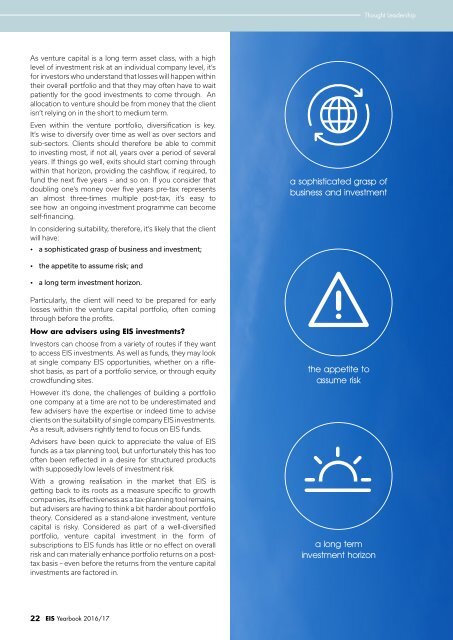2fnoNyY
2fnoNyY
2fnoNyY
Create successful ePaper yourself
Turn your PDF publications into a flip-book with our unique Google optimized e-Paper software.
Thought Leadership<br />
As venture capital is a long term asset class, with a high<br />
level of investment risk at an individual company level, it’s<br />
for investors who understand that losses will happen within<br />
their overall portfolio and that they may often have to wait<br />
patiently for the good investments to come through. An<br />
allocation to venture should be from money that the client<br />
isn’t relying on in the short to medium term.<br />
Even within the venture portfolio, diversification is key.<br />
It’s wise to diversify over time as well as over sectors and<br />
sub-sectors. Clients should therefore be able to commit<br />
to investing most, if not all, years over a period of several<br />
years. If things go well, exits should start coming through<br />
within that horizon, providing the cashflow, if required, to<br />
fund the next five years – and so on. If you consider that<br />
doubling one’s money over five years pre-tax represents<br />
an almost three-times multiple post-tax, it’s easy to<br />
see how an ongoing investment programme can become<br />
self-financing.<br />
In considering suitability, therefore, it’s likely that the client<br />
will have:<br />
• a sophisticated grasp of business and investment;<br />
a sophisticated grasp of<br />
business and investment<br />
• the appetite to assume risk; and<br />
• a long term investment horizon.<br />
Particularly, the client will need to be prepared for early<br />
losses within the venture capital portfolio, often coming<br />
through before the profits.<br />
How are advisers using EIS investments?<br />
Investors can choose from a variety of routes if they want<br />
to access EIS investments. As well as funds, they may look<br />
at single company EIS opportunities, whether on a rifleshot<br />
basis, as part of a portfolio service, or through equity<br />
crowdfunding sites.<br />
However it’s done, the challenges of building a portfolio<br />
one company at a time are not to be underestimated and<br />
few advisers have the expertise or indeed time to advise<br />
clients on the suitability of single company EIS investments.<br />
As a result, advisers rightly tend to focus on EIS funds.<br />
Advisers have been quick to appreciate the value of EIS<br />
funds as a tax planning tool, but unfortunately this has too<br />
often been reflected in a desire for structured products<br />
with supposedly low levels of investment risk.<br />
With a growing realisation in the market that EIS is<br />
getting back to its roots as a measure specific to growth<br />
companies, its effectiveness as a tax-planning tool remains,<br />
but advisers are having to think a bit harder about portfolio<br />
theory. Considered as a stand-alone investment, venture<br />
capital is risky. Considered as part of a well-diversified<br />
portfolio, venture capital investment in the form of<br />
subscriptions to EIS funds has little or no effect on overall<br />
risk and can materially enhance portfolio returns on a posttax<br />
basis – even before the returns from the venture capital<br />
investments are factored in.<br />
the appetite to<br />
assume risk<br />
a long term<br />
investment horizon<br />
22 EIS Yearbook 2016/17


